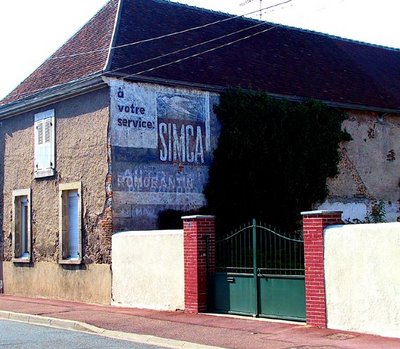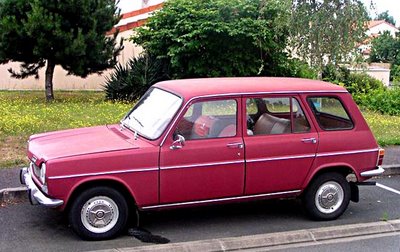Personally, I have a long history with Simcas, even though I don't think I've ever driven one. I don't even know if I've ever been a passenger in one. Production of the cars ceased in late 1970s or early 1980s, so this Simca-fascination of mine goes back quite some time.
In 1972-73, I lived in the city of Rouen in Normandy and worked as an English-language teaching assistant in a high school there. The job was part-time and the pay was low, so I didn't have a car that year. I also didn't need a car because I lived in the middle of the old city and could walk to work and to nearby shopping areas.
It was just as well, because I couldn't have afforded a car. I had sold my 1966 Ford Fairlane (I shudder to think I drove such a thing — it was a college graduation present from my father). when I left the States that summer of 1972.
I was fascinated with French cars and European cars in general. They seemed so much more sensible to me than the big "boats" so many Americans drove around in at the time. The Citroën 2CV (la Deux-Chevaux) and the Renault 4L were two of the most distinctive small cars in France back then. There were plenty of other models, too, but those two were really the people's cars of the time. You still see quite a few of each on the roads out here in the countryside.
And there was also the Simca 1100. It was an innovative model because it was one of the first hatchback cars, unless I'm mistaken. The 2CV was a four-dour sedan, and the 4L was a tiny station wagon. The hatchback was a new concept in those days. Hatchback models are still very popular in Europe, though they are kind out of fashion in the U.S. My little Peugeot 206, which is a 2001 model, is a hatchback. It's very practical.
 A 1961 Simca Aronde. The Aronde was introduced in the early 1950s.
A 1961 Simca Aronde. The Aronde was introduced in the early 1950s.This is the Simca model I remember seeing in North Carolina back then.
Thanks to Wikipedia for the photo.
Simca had some very successful cars in France in the 1950s, and I even remember that somebody in my home town in North Carolina had one in the late '50s or early '60s. At that time, there were still U.S. military bases in France, and I'm sure it was some of the returning military personnel who brought their European cars home with them. We learned to recognize Simcas and Renault Dauphines, as well as English Fords, Hillmans, and Vauxhalls, a few Fiats, and, of course, VW Beetles.
The Simca 1100 was a new model in 1967. It had front-wheel drive and independent suspension all-around. In addition to the hatchback, there was a station wagon. In all, about 2.2 million Simca 1100s were built.
Anyway, I really wanted a Simca. Chrysler had taken a controlling interest in the Simca company in the 1960s, and owned it outright by the early 1970s. Chrysler France kept the Simca brand name. I hoped that when I returned to the U.S. from Normandy in 1973 I would be able to buy myself a Simca 1100 from a Chrysler dealer. I was going to need a car in the U.S.
That wasn't to be, however. Chrysler didn't sell them in the U.S. I ended up buying a little German Opel 1900 from a Buick dealer in North Carolina. My father co-signed the loan for me, and the Buick dealer was where he bought his cars. He was scandalized that I would pay good money for such a little putt-putt car.
The brand-new light-blue Opel 1900 (called an Opel Ascona in Europe), with an AM radio, a heater, and a manual transmission, cost about $3,300. Such a deal! It didn't have air conditioning, FM radio, electric windows, or even power steering or power brakes. But it had four doors and a big trunk. It got good gas mileage. It was the best I could do.
I know I have a picture of that old Opel somewhere. I drove it until 1979, when I sold it to return to France one more time. The Opel got me back and forth from North Carolina to Lakeland, Florida, and Champaign, Illinois, many times. I don't remember how many miles I put on it, but I bet it was a lot. I think I sold it for $600 in August 1979.
So no Simca for me... not back then. The only Simca 1100 I've noticed since I've been in France this time is an orange one that I spotted last year down in Châtillon-sur-Indre. I was surprised to see one that was still, apparently, road-worthy.
The Simca wall-advertising I started this posting with led me to start looking around on the Web to see if there were any available. It turns out that there are a lot of classic Simca 1100 pictures on this site, and more at this one. Wikipedia has a good history of the brand (in English or in French).
And if you want to buy a Simca 1100 today, there are plenty of ads here. All the pictures of 1100s in this posting are ones I got from these ads (can't imagine anybody minding some free advertising).
 This is the Simca 1100 station wagon that a man in Blois is trying
This is the Simca 1100 station wagon that a man in Blois is tryingto sell. Sometimes we think having a second car would come in handy,
especially a station wagon. The guy wants 1200 euros for this one.
But... but... now I've learned that one is for sale in Blois. What is the attraction of these old cars? I'm very tempted to call the man who's selling it. I'm old enough to know better. I wonder if the thing would even make the 25-mile trip from Blois to Saint-Aignan without incident.
If I knew anything about working on car motors, having a classic car would make more sense. To be continued...







I remember la Simca 1000 we tooled around in! It was my rental of choice in the 70s. Lordy, tempus fugit!
ReplyDeleteWow, what good memory you have, Eleanor. I didn't remember that we had a Simca -- was it the one we rented in Bordeaux? I don't have any pictures from back then, as far as I know. We rented a car in Rouen too -- was that the Simca?
ReplyDeleteGood Morning:
ReplyDeleteBefore I get off to my daily business you might be interested in the comments of an American who did own a 1969 Simca 1204 (uprated version of the 1100)from 1971-1975.
The car was bought by my parents for me to use as a commuter for my final semester at the University of New Hamsphire. The 1204 was a blue, two-door hatchback with about 31,000 miles on the odometer at the time of purchase. It was the car on which I learned to shift a manual transmission. If I remember correctly there was no syncromesh in first gear.
The Simca was a comfortable, practical car, that gave an honest 33-34 mpg. The engine was reliable, and it was a good cold weather starter in cold and dry conditions (below freezing).
However, the Simca did not like cold and rainy weather and would frequently conk out in such conditions. This shortcoming stemmed from the upfront transverse placement of the plugs and points which left them exposed to any major puddles. My father, a very handy man, rigged up a plastic shield which could deflect water. This made for a marked improvement, but wet weather remained a tricky affair with the Simca.
I have usually given names to my cars. My current vehicle, a VW Golf, is named Nora. I initially christened the Simca Claudia, but not too long afterward re-named it Excedrin. For all its virtues, the car was an electrical nightmare. Beyond the above mentioned points & plugs problem, some electrical wire was always working its way loose and shorting. Particulary vexatious were the wires in the steering column connecting to the horn. They would frequently unravel themselves while driving, and the horn would start to blow. There I would be, driving down a road at 50+, hitting a bump, and the horn going toot, toot!
The Simca died at the end of 1975 while I was in graduate school. I had stopped at a light, and when it came to go an alarming squeel emerged from the front. A main bearing had gone kaput. With 99,400 miles on the odometer Excedrin had given up the ghost. A classmate, believe it or not, had a father who was a Simca fan (he had at least two and he glady bought Excedrin for parts for $100.
Thus ended my one experience with French cars. Incidentally Chrysler did sell the 1100 and 1204here in the States from 1969-71. The data indicates that they sold about 15,000-16,000 over the three years, so they are quite scarce. The one thing that can be said about Excedrin is that it sold me on the hatchback/small wagon concept. When it came to buy my first "real" new car it was a 77 VW Rabbit, and I have generally been a VW customer since. My current transport is a 2000 Golf with 193,000 miles on the odometer, still on its orginal clutch. I see no reason why "Nora" (the VWs were Eleanor and Maude) and I should not see 200,000 miles and am thinking of going for the 250,000 mark.
Wow! Look at the time! I don't recall how I stumbled on your site, but it is clear you love France. Thanks for the opportunity to take a reiminiscence down memory lane.
Dave Whall
West Hartford, Connecticut
whall_david@yahoo.com